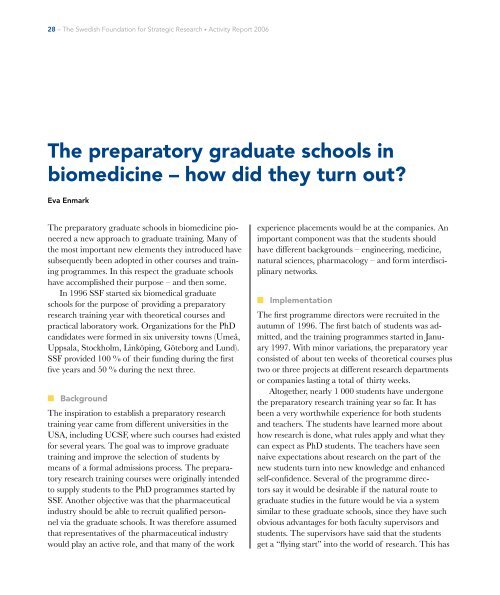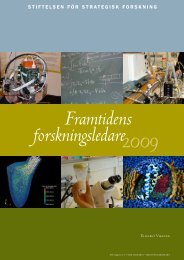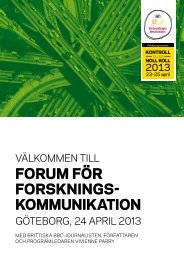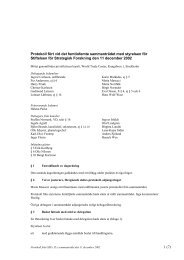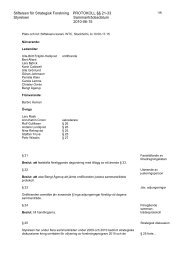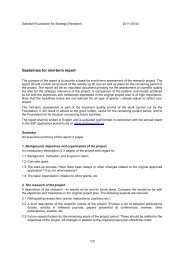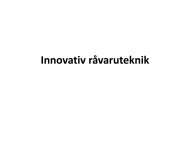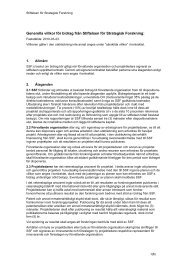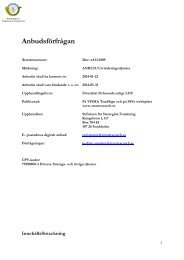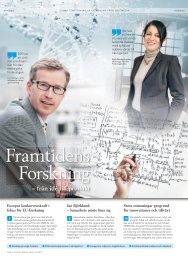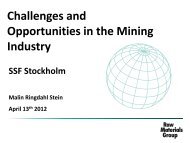Swedish Foundation for Strategic Research Activity Report 2006
Swedish Foundation for Strategic Research Activity Report 2006
Swedish Foundation for Strategic Research Activity Report 2006
Create successful ePaper yourself
Turn your PDF publications into a flip-book with our unique Google optimized e-Paper software.
28 – The <strong>Swedish</strong> <strong>Foundation</strong> <strong>for</strong> <strong>Strategic</strong> <strong>Research</strong> • <strong>Activity</strong> <strong>Report</strong> <strong>2006</strong>The preparatory graduate schools inbiomedicine – how did they turn out?Eva EnmarkThe preparatory graduate schools in biomedicine pioneereda new approach to graduate training. Many ofthe most important new elements they introduced havesubsequently been adopted in other courses and trainingprogrammes. In this respect the graduate schoolshave accomplished their purpose – and then some.In 1996 SSF started six biomedical graduateschools <strong>for</strong> the purpose of providing a preparatoryresearch training year with theoretical courses andpractical laboratory work. Organizations <strong>for</strong> the PhDcandidates were <strong>for</strong>med in six university towns (Umeå,Uppsala, Stockholm, Linköping, Göteborg and Lund).SSF provided 100 % of their funding during the firstfive years and 50 % during the next three.n BackgroundThe inspiration to establish a preparatory researchtraining year came from different universities in theUSA, including UCSF, where such courses had existed<strong>for</strong> several years. The goal was to improve graduatetraining and improve the selection of students bymeans of a <strong>for</strong>mal admissions process. The preparatoryresearch training courses were originally intendedto supply students to the PhD programmes started bySSF. Another objective was that the pharmaceuticalindustry should be able to recruit qualified personnelvia the graduate schools. It was there<strong>for</strong>e assumedthat representatives of the pharmaceutical industrywould play an active role, and that many of the workexperience placements would be at the companies. Animportant component was that the students shouldhave different backgrounds – engineering, medicine,natural sciences, pharmacology – and <strong>for</strong>m interdisciplinarynetworks.n ImplementationThe first programme directors were recruited in theautumn of 1996. The first batch of students was admitted,and the training programmes started in January1997. With minor variations, the preparatory yearconsisted of about ten weeks of theoretical courses plustwo or three projects at different research departmentsor companies lasting a total of thirty weeks.Altogether, nearly 1 000 students have undergonethe preparatory research training year so far. It hasbeen a very worthwhile experience <strong>for</strong> both studentsand teachers. The students have learned more abouthow research is done, what rules apply and what theycan expect as PhD students. The teachers have seennaive expectations about research on the part of thenew students turn into new knowledge and enhancedself-confidence. Several of the programme directorssay it would be desirable if the natural route tograduate studies in the future would be via a systemsimilar to these graduate schools, since they have suchobvious advantages <strong>for</strong> both faculty supervisors andstudents. The supervisors have said that the studentsget a “flying start” into the world of research. This has


